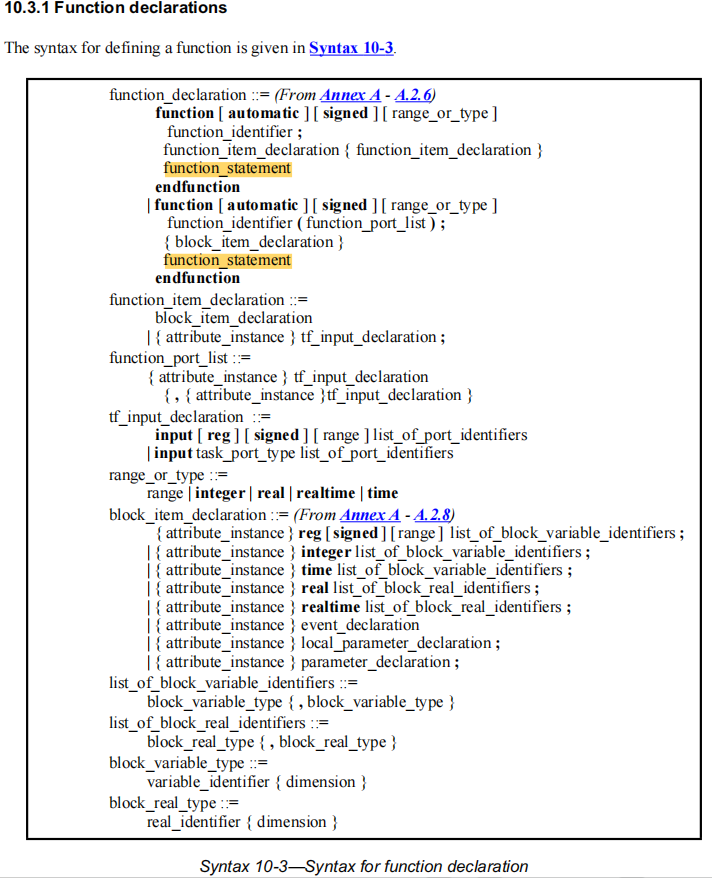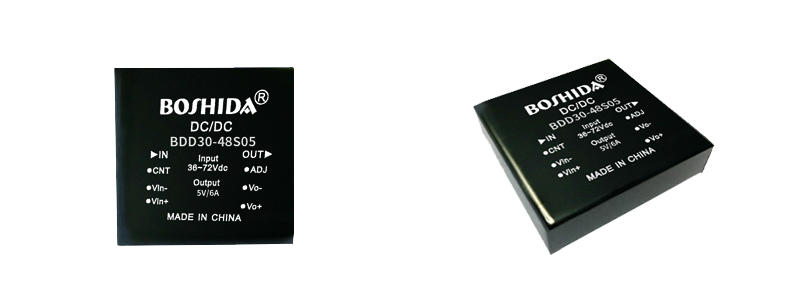1、function的使用場景
function的作用返回一個數值,此數值由一串組合邏輯代碼計算得到。
那為什么要用function呢?主要有兩大原因:
a)當組合邏輯實現的功能比較復雜,無法用少量代碼完成編寫,使用function替代,不用在always塊里面寫一大堆的組合邏輯,會使得代碼邏輯更加清晰,可讀性強。
b)當組合邏輯實現的功能在同一個模塊內被多次調用,所有使用此功能的代碼只需要調用function就可以了,有效減少編碼量,而且只需檢查function實現功能是否正確,也能夠降低錯誤率,減少bug。
2、Function 規則
a) function結構內不可以使用任何時間控制,例如不可使用#, @, wait等關鍵字
b) functions 不可以調用task
c) function 至少有一個input申明.
d) function 不能有任何output或者inout申明
e) function 不能使用任何非阻塞賦值(<=)或程序連續賦值(assign and force).
f) function不能使用任何事件觸發語句(always@語句)
3、Function使用說明
協議中的2種格式
function [ automatic ] [ signed ] [ range_or_type ] function_identifier ; function_item_declaration { function_item_declaration } function_statement endfunction
function [ automatic ] [ signed ] [ range_or_type ] function_identifier ( function_port_list );
{ block_item_declaration }
function_statement
endfunction
可選擇的關鍵字automatic和signed設計人員一般不使用,此處不再描述,請詳細描述請見verilog標準(IEEE P1364-2005)
range_or_type指定function返回的數值是real、integer、time、realtime 或者位寬為 [n:m]的數值。
如果range_or_type缺失,則默認function_identifier是1bit的。
function_identifier就是function_name(代表你期望function計算出的結果),function中會隱形地定義一個變量,變量名稱就是function_name,最終會把function_statement計算得出的結果賦值給function_name,在調用function_name時,會返回計算結果。
item_declaration是內部變量等的申明,設計中常見為reg [xx:xx] reg_name1; localparameter PARA_NEME ;
integer i;
function_statement 是function實現的邏輯功能,在可綜合設計中,就是一串組合邏輯。
兩種格式的兩個案例:
//第一種格式: function [7:0] getbyte; input [15:0] address; begin // code to extract low-order byte from addressed word . . . getbyte = result_expression; end endfunction //第二種格式:input在括號中 function [7:0] getbyte (input [15:0] address); begin // code to extract low-order byte from addressed word . . . getbyte = result_expression; end endfunction
Verilog標準對function定義的描述:

4、function案例
案例1:格雷碼轉二進制
wire [ADDR_WIDTH:0] raddr_sync ; wire [ADDR_WIDTH:0] raddr_gray_sync ; //fifo raddr address gray to bin assign raddr_sync = gray2bin(raddr_gray_sync);//fifo raddr address gray to bin function [ADDR_WIDTH:0] gray2bin; //to change the gray code to bin code input [ADDR_WIDTH:0] gray_in; //input gray code reg [ADDR_WIDTH:0] gray_code; //reg gray reg [ADDR_WIDTH:0] bin_code; //bin code result integer i,j; //integer reg tmp; //tmp begin gray_code = gray_in; for(i=0;i<=ADDR_WIDTH;i=i+1) begin tmp=1'b0; for(j=i;j<=ADDR_WIDTH;j=j+1) tmp=gray_code[j]^tmp; bin_code[i]=tmp; end gray2bin= bin_code; end endfunction
案例2--CRC計算
module CRC32_D8(DATA_IN, CLK, RESET, START, LOAD, CRC_IN, CRC_OUT);
input [7:0] DATA_IN;
input CLK;
input RESET;
input START;
input LOAD;
input [31:0] CRC_IN;
output [31:0] CRC_OUT;
reg [31:0] CRC_OUT;
reg start_int;
reg [7:0] data_int;
always @(posedge CLK)
begin
start_int <= START;
data_int <= DATA_IN;
end
always @(posedge CLK or posedge RESET)
begin
if (RESET) begin
CRC_OUT <= 0;
end
else if (start_int == 1) begin
CRC_OUT <= nextCRC32_D8(data_int, CRC_OUT);
end
else if (LOAD == 1) begin
CRC_OUT <= CRC_IN;
end
end
// polynomial: (0 1 2 3 4 5 7 8 10 11 12 16 22 23 26 32)
// data width: 8
// convention: the first serial data bit is D[7]
function [31:0] nextCRC32_D8;
input [7:0] Data;
input [31:0] CRC;
reg [7:0] D;
reg [31:0] C;
reg [31:0] NewCRC;
begin
D = Data;
C = CRC;
NewCRC[0] = D[6] ^ D[0] ^ C[24] ^ C[30];
NewCRC[1] = D[7] ^ D[6] ^ D[1] ^ D[0] ^ C[24] ^ C[25] ^ C[30] ^
C[31];
NewCRC[2] = D[7] ^ D[6] ^ D[2] ^ D[1] ^ D[0] ^ C[24] ^ C[25] ^
C[26] ^ C[30] ^ C[31];
NewCRC[3] = D[7] ^ D[6] ^ D[3] ^ D[2] ^ D[1] ^ D[0] ^ C[24] ^ C[25] ^
C[26] ^ C[27] ^ C[30] ^ C[31];
NewCRC[4] = D[7] ^ D[6] ^ D[4] ^ D[3] ^ D[2] ^ D[1] ^ D[0] ^ C[24] ^
C[25] ^ C[26] ^ C[27] ^ C[28] ^ C[30] ^ C[31];
NewCRC[5] = D[7] ^ D[6] ^ D[5] ^ D[4] ^ D[3] ^ D[2] ^ D[1] ^ D[0] ^
C[24] ^ C[25] ^ C[26] ^ C[27] ^ C[28] ^ C[29] ^ C[30] ^
C[31];
NewCRC[6] = D[7] ^ D[6] ^ D[5] ^ D[4] ^ D[3] ^ D[2] ^ D[1] ^ C[25] ^
C[26] ^ C[27] ^ C[28] ^ C[29] ^ C[30] ^ C[31];
NewCRC[7] = D[7] ^ D[5] ^ D[4] ^ D[3] ^ D[2] ^ D[0] ^ C[24] ^ C[26] ^
C[27] ^ C[28] ^ C[29] ^ C[31];
NewCRC[8] = D[5] ^ D[4] ^ D[3] ^ D[1] ^ D[0] ^ C[0] ^ C[24] ^ C[25] ^
C[27] ^ C[28] ^ C[29];
NewCRC[9] = D[6] ^ D[5] ^ D[4] ^ D[2] ^ D[1] ^ C[1] ^ C[25] ^ C[26] ^
C[28] ^ C[29] ^ C[30];
NewCRC[10] = D[7] ^ D[5] ^ D[3] ^ D[2] ^ D[0] ^ C[2] ^ C[24] ^ C[26] ^
C[27] ^ C[29] ^ C[31];
NewCRC[11] = D[4] ^ D[3] ^ D[1] ^ D[0] ^ C[3] ^ C[24] ^ C[25] ^
C[27] ^ C[28];
NewCRC[12] = D[6] ^ D[5] ^ D[4] ^ D[2] ^ D[1] ^ D[0] ^ C[4] ^ C[24] ^
C[25] ^ C[26] ^ C[28] ^ C[29] ^ C[30];
NewCRC[13] = D[7] ^ D[6] ^ D[5] ^ D[3] ^ D[2] ^ D[1] ^ C[5] ^ C[25] ^
C[26] ^ C[27] ^ C[29] ^ C[30] ^ C[31];
NewCRC[14] = D[7] ^ D[6] ^ D[4] ^ D[3] ^ D[2] ^ C[6] ^ C[26] ^ C[27] ^
C[28] ^ C[30] ^ C[31];
NewCRC[15] = D[7] ^ D[5] ^ D[4] ^ D[3] ^ C[7] ^ C[27] ^ C[28] ^
C[29] ^ C[31];
NewCRC[16] = D[5] ^ D[4] ^ D[0] ^ C[8] ^ C[24] ^ C[28] ^ C[29];
NewCRC[17] = D[6] ^ D[5] ^ D[1] ^ C[9] ^ C[25] ^ C[29] ^ C[30];
NewCRC[18] = D[7] ^ D[6] ^ D[2] ^ C[10] ^ C[26] ^ C[30] ^ C[31];
NewCRC[19] = D[7] ^ D[3] ^ C[11] ^ C[27] ^ C[31];
NewCRC[20] = D[4] ^ C[12] ^ C[28];
NewCRC[21] = D[5] ^ C[13] ^ C[29];
NewCRC[22] = D[0] ^ C[14] ^ C[24];
NewCRC[23] = D[6] ^ D[1] ^ D[0] ^ C[15] ^ C[24] ^ C[25] ^ C[30];
NewCRC[24] = D[7] ^ D[2] ^ D[1] ^ C[16] ^ C[25] ^ C[26] ^ C[31];
NewCRC[25] = D[3] ^ D[2] ^ C[17] ^ C[26] ^ C[27];
NewCRC[26] = D[6] ^ D[4] ^ D[3] ^ D[0] ^ C[18] ^ C[24] ^ C[27] ^
C[28] ^ C[30];
NewCRC[27] = D[7] ^ D[5] ^ D[4] ^ D[1] ^ C[19] ^ C[25] ^ C[28] ^
C[29] ^ C[31];
NewCRC[28] = D[6] ^ D[5] ^ D[2] ^ C[20] ^ C[26] ^ C[29] ^ C[30];
NewCRC[29] = D[7] ^ D[6] ^ D[3] ^ C[21] ^ C[27] ^ C[30] ^ C[31];
NewCRC[30] = D[7] ^ D[4] ^ C[22] ^ C[28] ^ C[31];
NewCRC[31] = D[5] ^ C[23] ^ C[29];
nextCRC32_D8 = NewCRC;
end
endfunction
案例3-輸入數據datain中bit 1的數量大于2,則返回XBC為1
module functionCall(XBC, DataIn);
output XBC;
input [0:5] DataIn;
function [0:2] CountOnes;
input [0:5]A;
integer K;
begin
CountOnes =0;
for(X=0;R<=5;K=X+1)
if(A[K])
CountOnes = Countones +1;
end
endfunction
// If number of ones in DataIn is greater than 2, return 1 in XBC.
aasigm XBC = CountOnes (DataIn)>2;
endmodule
審核編輯:劉清
-
二進制
+關注
關注
2文章
796瀏覽量
41728 -
Verilog
+關注
關注
28文章
1351瀏覽量
110258 -
CRC校驗
+關注
關注
0文章
84瀏覽量
15258
原文標題:verilog語法-使用function提高效率
文章出處:【微信號:IP與SoC設計,微信公眾號:IP與SoC設計】歡迎添加關注!文章轉載請注明出處。
發布評論請先 登錄
相關推薦
明德揚視頻分享點撥FPGA課程--第二十章??提高效率技巧
如何使用UCC28056優化過渡模式PFC設計來提高效率和待機功耗?
keil5提高效率的技巧
卡套管的使用有助于提高效率并達到更合格的標準
LFPAK88是提高效率的捷徑

NIKKEI邏輯整合Brocade SAN以提高效率和安全性

提高效率的DC電源模塊設計技巧





 verilog語法-如何使用function提高效率?
verilog語法-如何使用function提高效率?










評論